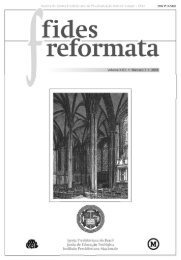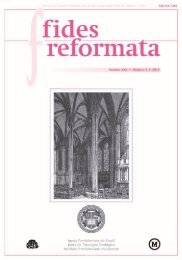Fides 22 N2
Um publicação do Centro Presbiteriano de Pós-graduação Andrew Jumper.
Um publicação do Centro Presbiteriano de Pós-graduação Andrew Jumper.
Create successful ePaper yourself
Turn your PDF publications into a flip-book with our unique Google optimized e-Paper software.
ELIAS MEDEIROS, THE REFORMERS AND MISSIONS<br />
But why did the Protestants not even try to reach out? Some scholars point to<br />
the fact that the Protestants did not have a global network of colonial outreach.<br />
Well, the Dutch Protestants did. And, their ships, unlike those from Catholic<br />
countries, carried no missionaries. 84<br />
These bold declarations, represented as historical fact, lack any supporting<br />
documentation. Winter, like Kane, is accepting at face value secondary sources<br />
that have not been well exegeted or considered in the light of original sources.<br />
Winter also assumes that the reformers’ lack of “religious orders,” and<br />
even their opposition to them, contributed to their mission inactivity. In his<br />
overused article, “The Two Structures of Redemptive Mission,” 85 Winter<br />
laments the fact that the “Lutheran movement did not in a comparable sense<br />
readopt the sodalities, the Catholic orders, that had been so prominent in the<br />
Roman tradition.” 86 Such “omission,” according to Winter’s evaluation, “represents<br />
the greatest error of the Reformation and the greatest weakness of<br />
the resulting Protestant tradition.” 87 Winter goes further in his evaluation<br />
by concluding that “Once this method of operation was clearly understood by<br />
the Protestants, 300 years of latent energies burst forth in what became, in<br />
Latourette’s phrase, ‘The Great Century.’” 88 Winter, therefore, sees the lack<br />
of Protestant “orders” as the main cause of the reformers’ indifference toward<br />
even the “talk of mission outreach.”<br />
Winter’s theory of modality/sodality is too simplistic and lacks any<br />
consideration of the reformers’ biblical exegesis and theology of the church.<br />
Winter, like Kane, assumes too much regarding the Roman Catholic orders.<br />
He does not deal with the doctrinal and theological merits of such orders and<br />
assumes that any opposition to the so called missionary religious orders implies<br />
opposition and indifference to the preaching of the gospel to the whole world.<br />
Winter imposes his “two structures” model (modality and sodality) upon the<br />
biblical text and uses this model borrowed from the Roman Catholic Church<br />
to criticize the reformers’ opposition to the use of any “missionary society”<br />
(Jesuits, Dominicans, Franciscans, etc.) apart from the church. The debate<br />
84 Ibid.<br />
85 Winter’s article is easily accessed and can be downloaded from several webpages. Check,<br />
for instance, the following webpages: http://www.undertheiceberg.com/wpcontent/uploads/2006/04/<br />
SodalityWinter%20on%20Two %20Structures1.pdf; http://resources.campusforchrist.org/images/4/48/<br />
The_Parachruch.pdf; http://pcmsusa.org/ articles/The%20Two%20Structures%20of%20God%27s%20<br />
Redemptive%20Mission.pdf.<br />
86 Ralph D. Winter, “The Two Structures of Redemptive Mission” in Perspectives of the World<br />
Christian Movement: A Reader, Ralph Winter ed. (Pasadena: William Carey Library, 1999), chapter<br />
35; <strong>22</strong>6.<br />
87 Winter, “The Two Structures,” <strong>22</strong>6. Italics added.<br />
88 Ibid., <strong>22</strong>7.<br />
158




